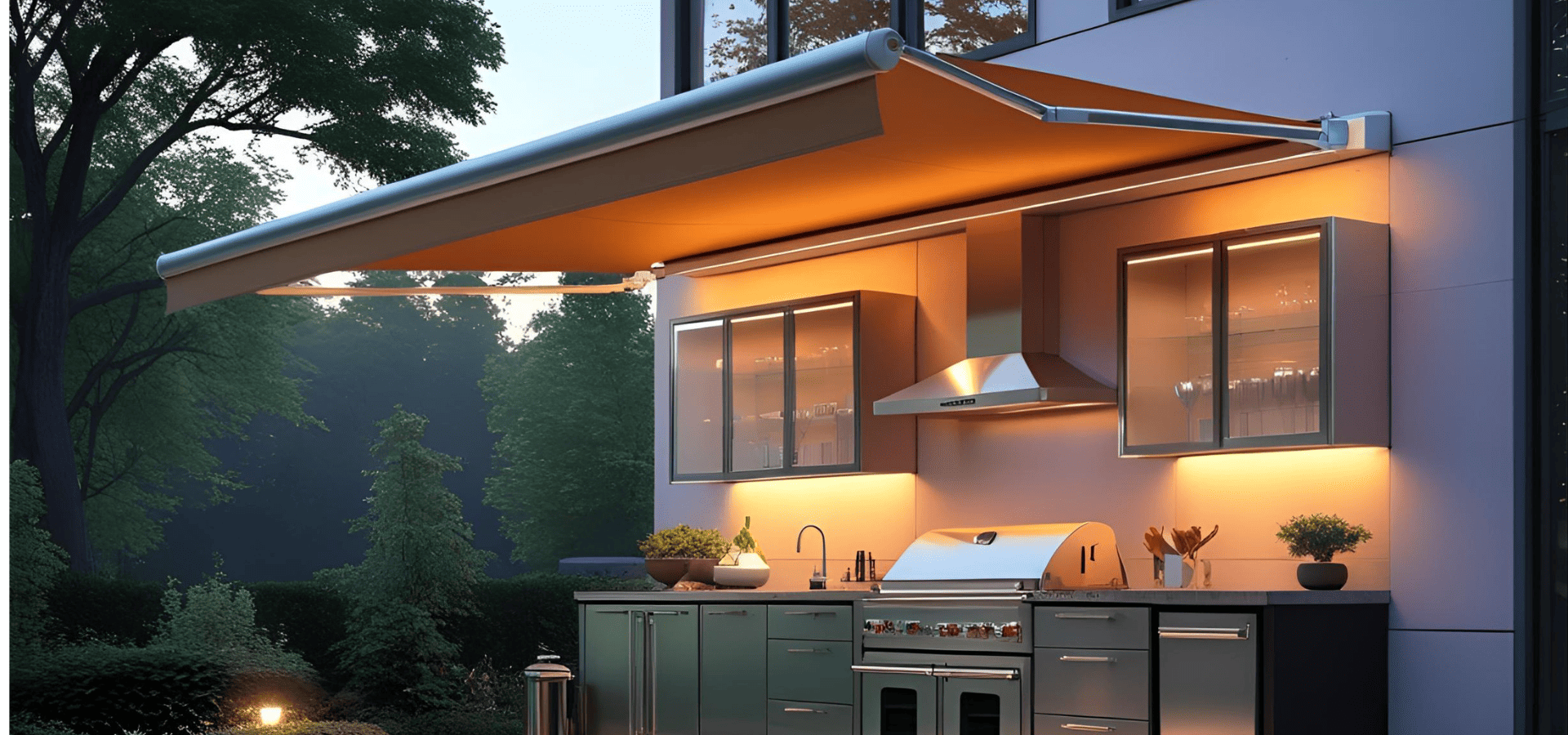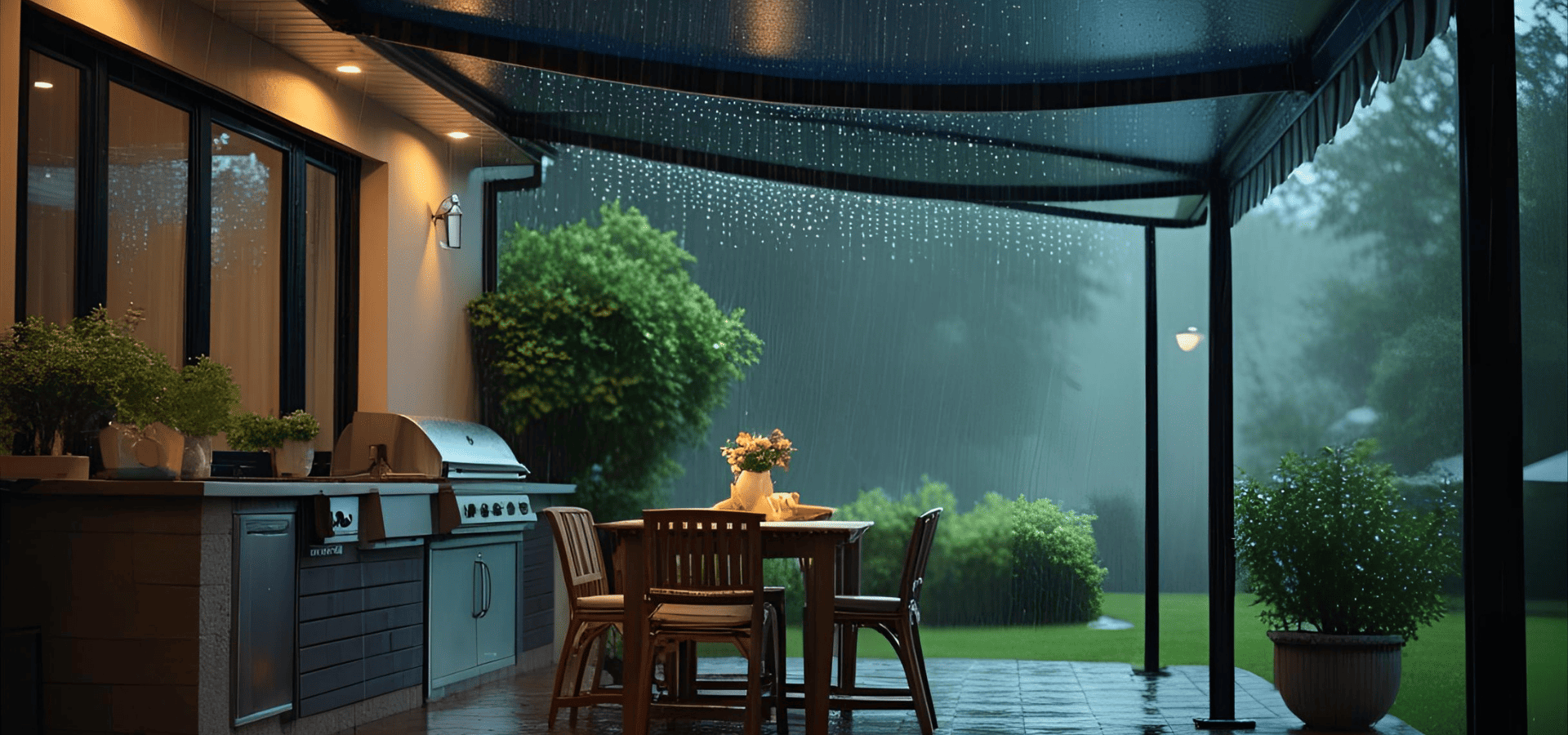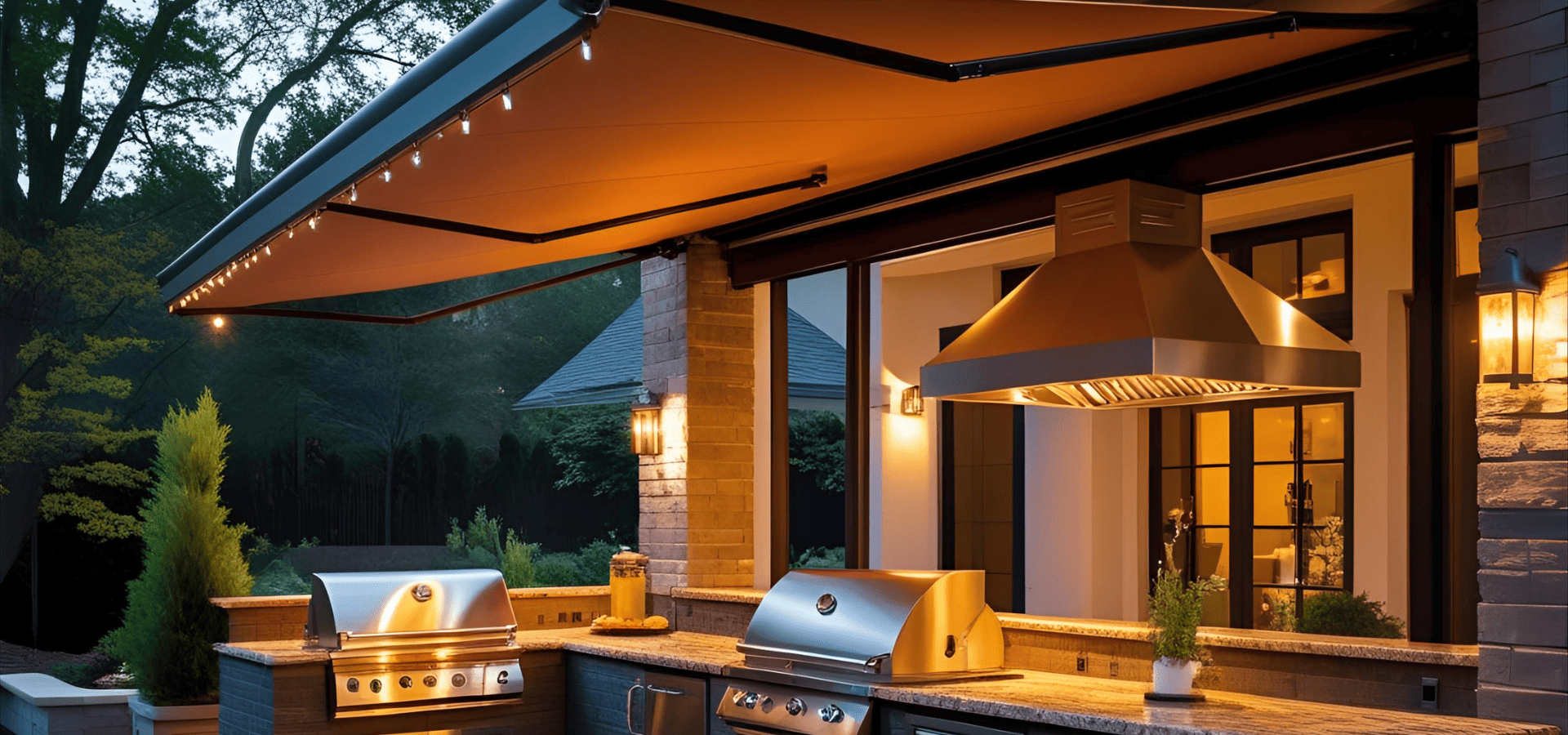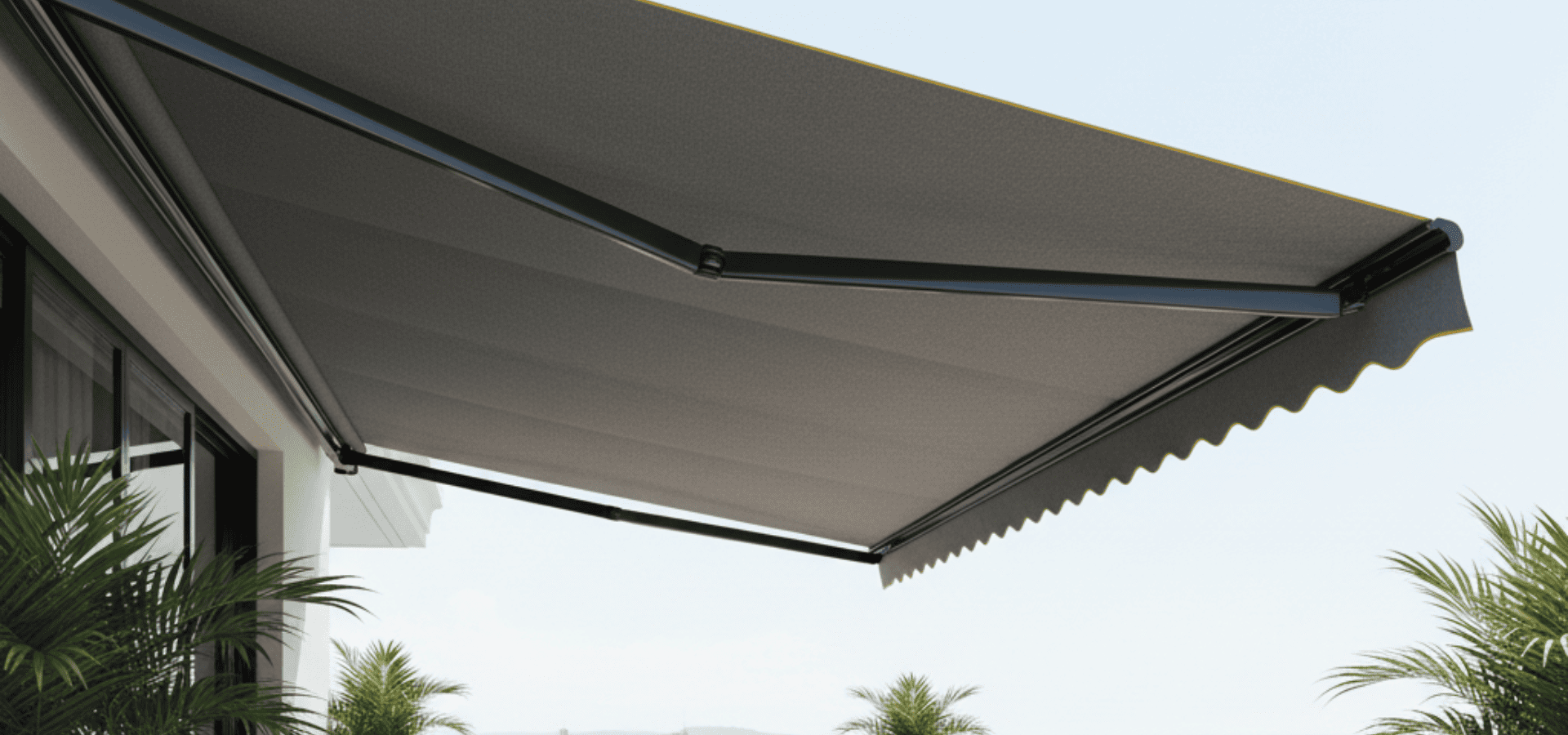Awnings For Outdoor Kitchens & BBQ Areas
There’s something deeply satisfying about an outdoor kitchen that actually works. And we’re not just talking one that looks the part… We’re talking one that handles the hustle.
Searing steaks under open skies… Pouring drinks beneath string lights… Hosting dinner without scanning the clouds every five minutes…
If you want the lifestyle, the bottom line is that you have to invest in it.
Because for all that promise and curb-appeal glory, one thing that separates a truly usable space from a short-season novelty is the shelter. Not the collapsible kind that wilts in the wind or sours after a week of rain. We’re talking real, integrated shade — sharp enough to handle heat, rain, and breeze, while still being subtle enough to lift the whole setup.
Awnings are precisely that investment. Done right, they don’t just block sun: they shape your space. They expand your comfort zone, stretch your season, and keep the BBQ vibes alive even when the weather’s picking a fight.
So let’s explore how to invest in an awning the right way.
Do You Really Need An Outdoor Awning?
Outdoor kitchens are all about extending the indoors outside. You’re turning open-air into something just as liveable, practical, and comfortable as the space inside. But the second you take off the roof, you’re inviting in the elements, and rain doesn’t RSVP to your neighborhood BBQ.
Awnings resolve this tension. They bring overhead coverage without boxing you in. Unlike pergolas or permanent structures, they adapt — retracting when you want the light, rolling out when you need the cover.
However, unlike less impressive solutions such as umbrellas or pop-ups, they’re also built to last. Proper awnings are anchored, engineered for wind, and ready for years of sun and storm.
But invisibly, they also do something quieter: they define the space. A thoughtfully placed awning says, “This is the kitchen.” Or, “This is where you sip chardonnay while I char the brinjal.”
It’s architectural punctuation — the line between lounging and grilling. The subtext between background chatter and BBQ mastery where a memorable gathering exists.
Fixed vs Retractable Awnings

First big choice: do you want your awning to move, or stay put?
- Fixed awnings are permanent. They’re supported by posts or beams, tough enough for real weather, and great over outdoor kitchens with built-in gear where year-round protection matters. But once they’re up, they’re up; you can’t adjust them to catch the midday sun.
- Retractable awnings, instead, offer options. You can have shade when you’re prepping lunch, and then open sky when the sun drops. Some use hand cranks; others rely on motorised arms, and the best retractable awnings will even have sensors that adjust to the weather on their own.
Additionally…
- Grease- and heat-resistant materials are key for BBQ setups. Look for fabrics designed to handle high temps, airborne oils, and smoke without warping, staining, or wearing out too soon. These are built for real cooking.
- Open-frame awning designs let smoke and heat rise and escape naturally. They’re ideal when you want airflow without trapping the kitchen in a heat pocket, especially useful in humid climates or during high-sizzle weekends.
Overall, retractable awnings are the better option for hybrid setups, such as BBQ zones that double as social spaces. But ultimately, there’s no universal winner here.
If your setup leans hard into all-season function, fixed may win out. But if your space is about ambience, flexibility, and flow, retractable’s the way to go.
Strategic Placement
You don’t just bolt an awning above the BBQ and call it done. Placement matters, especially in outdoor kitchens where airflow, visibility, and heat dynamics all play a part.
A good awning does more than hover over the grill. It should cover your prep zone, give diners a buffer, and steer clear of trapping smoke. Aim for shelter where you stand and serve, not where the flames do their thing.
The sun’s orientation is crucial to consider too. South-facing spots get all-day rays. West-facing patios cop that harsh afternoon glare. A slight tilt or front valance can help, but the pitch and placement are still king. A level awning might look sleek, but if it’s not sloped at least 14 degrees, water’s not draining — and that’s just courting disaster when the monsoon arrives.
Don’t forget about the vertical clearance either! You want room for tall guests, proper smoke flow, and appliance venting. Prioritise placement: outdoor awnings aren’t the place for a “just fits” mentality.
Choosing The Awning Fabric & Frame
This is not the place to cheap out. Your awning’s materials matter.
Pick the wrong fabric, and you’re looking at fading, sagging, trapped heat, or mildew by the second summer. Meanwhile, the wrong frame results in rust, rattles, and regret.
Go for outdoor-grade fabric, either
- Solution-dyed acrylic
- Vinyl
- Or polyester
These don’t just hold colour better; they’re built for UV, rain, and grime. If your kitchen runs warm, a breathable mesh weave can help as well. And always check the fire rating, every single time. You’re cooking under this thing, and no doubt your guests would prefer if you didn’t tempt fate.
As for frame materials
- Aluminum is lightweight, rust-resistant, and strong.
- Stainless steel is also solid and great for salty air, but it’s heavier and costs more.
Whatever you choose, avoid plastic clips or rickety bolts. Look for solid joints, quality fixings, and powder-coated finishes.
Your awning doesn’t have to vanish, but it should complement the space. No one wants a “bolt-on eyesore” interrupting the vibe.
Weather Protection

Showroom patios don’t get hit with sideways rain….
But yours might.
That’s why our benchmarks are so important! Start with wind class ratings: retractables usually range from Class 1 (light wind) to Class 3 (strong gusts). In Singapore, the gusts can hit hard, particularly from Sumatran squalls at the wrong time of year. So Class 3 is going to be your best bet.
But rain matters too. “Water-resistant” still means it’ll soak through eventually. What you need is waterproof fabric, one with good tension and a smart pitch. If you don’t have that, your awning will suffer from pooling water, stretched fabric, and unnecessary strain on the brackets. And pretty soon, you’ll be dealing with repairs that cost more than the BBQ!
If you live in a windy area, we recommend going with a motorised awning complete with wind sensors. They’ll retract the awning before things get rough.
(Just don’t trust them blindly! Batteries fail, sensors miss cues… If in doubt, bring it in.)
Ventilation
Shelter is amazing! Suffocation…? Not so much.
Grills produce smoke, and gas burners release carbon monoxide. All that trapped heat and stagnant gas under fabric can turn your chill BBQ setup into a humid smokehouse.
Balance is the key here. Use the awning to cover your activity zone, but not to trap it. Keep side walls open. Don’t hang fabric behind flames. And if you’re using vented hoods or chimneys, make sure nothing blocks their flow.
Some setups split the difference: they use awnings over prep and serve zones, with a pergola or chimney hood over the grill. It takes more planning, but it’s safer, smarter, and better for everyone’s lungs.
Or for full chef-grade, some modern awnings even offer airflow channels or side screens that block wind but let air through. Ask your installer what’s possible.
Aesthetics

It’s tempting to treat the awning as a background extra. Just get it in grey and move on, right?
But the best outdoor kitchens don’t ignore aesthetics. They use every trick to make a space that feels as good as it works.
Fabric colour, valance shape, casing style — these all add to your awning’s vibe. Earth tones are classic for blending into the landscape, but a subtle stripe or warm neutral can add texture without clashing. Just avoid dark colours in hot climates as they trap heat fast.
Lighting’s another win too! Integrated LEDs or easy wiring access make evening prep way easier. And a little ambient glow over the chopping board is the chef’s kiss in every sense of the term.
If it all seems a bit much, you can even get smart controls installed (e.g., app toggles or voice activation). It’s not essential, but if it makes you use the space more, why not enjoy the luxury?
Maintenance: Not Glamorous, But It’ll Save You Money
Awning care isn’t a full-time job. However, a little effort does still go a long way.
Each season, wash the fabric with mild soap and a soft brush. Next, rinse it well, and then let the awning dry completely before retracting it. (And check that drainage holes are clear too.)
Twice a year, you should also inspect the brackets. Look for things like:
- Signs of rust
- Stress points
- Warping or flexing
- Or any movement or sounds that shouldn’t be occurring
If something’s loose, call a professional Singapore awning contractor, especially for motorised setups where tension systems get tricky.
Lastly, the golden rule is to always retract when in doubt. Windy day? Snow incoming? Sudden downpour?
Then put your awning away. You’re not winning points by leaving it out.
When The Awning’s Doing Its Job, You Use the Space More
A great awning isn’t flashy. It just quietly stretches the window of what your outdoor kitchen can handle. Brunch under a light drizzle, or maybe summer cocktails without the sunburn.
An awning isn’t just shade: it’s structure. It’s a way to turn open space into a room with presence, protection, and the occasional smoky, salivating waft of grilled halloumi.
So take the time. Think about your layout, your habits, your weather… Choose something that works with how you live, not just how your Pinterest board looks.
Because once it’s up, locked in, and not sagging from yesterday’s thunderstorm, then you’ll get it. This isn’t just a BBQ zone. It’s a liveable extension of your home.
One that smells downright delectable.


